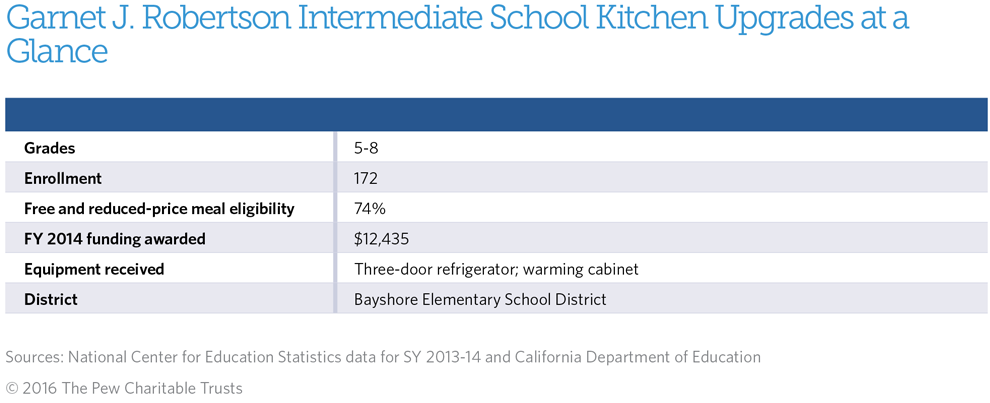Garnet J. Robertson Intermediate School
Daly City, California
Just south of San Francisco sits Bayshore Elementary School District, one of the Bay Area’s smallest, with just under 400 students, divided between an elementary school and Robertson Intermediate. Neither school has a full-service kitchen, and for years, they both relied on a neighboring district’s food service management company to prepare and deliver meals each morning. At Robertson, a small, aging refrigerator and a warming cabinet held the prepared food until lunchtime.
In 2015, Superintendent Audra Pittman and Merl Sabado, Robertson’s food service manager, nurse, secretary, and counselor, decided this arrangement was unacceptable because it left the school with no control over the types or quality of food its students received. “Our students depend on a good, nutritious lunch to get them through the rest of the school day, just as I did when I was [a student] here,” Sabado says. “I want to make sure it’s top quality.”
So the district applied for and received a U.S. Department of Agriculture kitchen equipment grant to purchase a larger three-door refrigerator and warming oven for Robertson. The upgrades helped the school increase the number and appeal of its entree options and made it possible for the district to contract directly with a different meal vendor for the 2015-16 school year.
“We absolutely needed new equipment; what we had barely functioned,” Pittman says, recalling days when the old warming cabinet would break down and staff would resort to reheating lunches in an oven in the teachers lounge. The new equipment is more dependable and energy-efficient and has helped simplify food service tasks, Pittman notes.
Compared with the old unit, the warming oven can hold larger quantities of cooked entrees at safe temperatures. Similarly, the refrigerator can store more fruit and vegetables and keep them at peak crispness longer, giving school officials the confidence to purchase fresh produce in larger quantities, which provides significant cost savings.
To help ensure that these investments would translate into healthier eating, Sabado sought kids’ input about their favorite fruits and vegetables. Her outreach has inspired excitement among the students about their new options and boosted the meal program’s popularity.
“The food is really good. It’s much better than last year,” says one student cafeteria helper.
Such endorsements are an important sign of progress to Principal Sergio Nesterov, who sits down with students to enjoy a school lunch in the cafeteria each day. “I want them to see me eating just what they’re served. If it’s good enough for them, it’s good enough for me,” Nesterov says.
The USDA-funded appliance purchases also were made with Bayshore’s overall facilities plan in mind. In a few years, Pittman, Nesterov, Sabado, and their staff expect to move into a new building that will house both the elementary and intermediate grades and will have a modern, full-service kitchen as one of its key features. The refrigerator and warming oven were purchased with suitability for this new facility in mind and will fit seamlessly into the district’s expanded food service operation, providing healthy meals for all children and teachers in the district.
“I can’t wait,” Sabado says of the planned kitchen. “That will help us give the students the kind of fresh, appealing meals they would get at home.”







